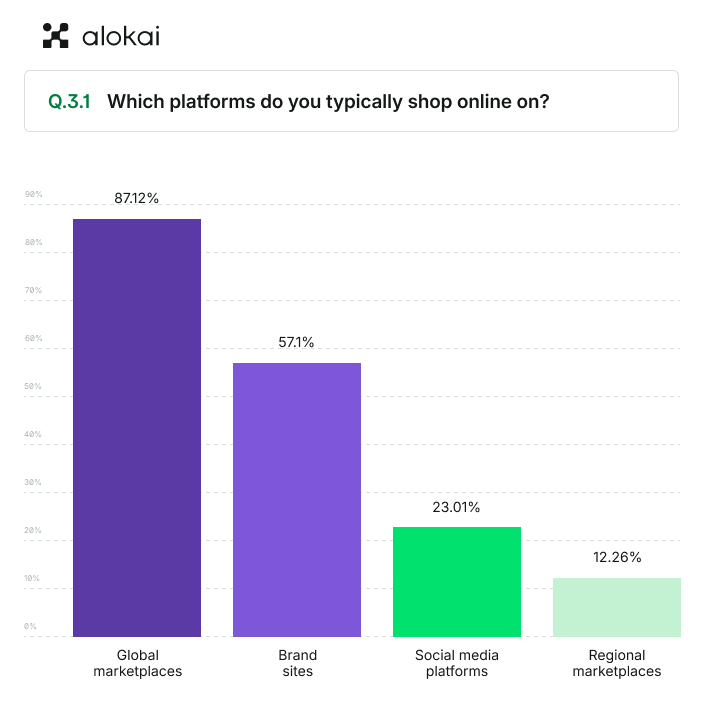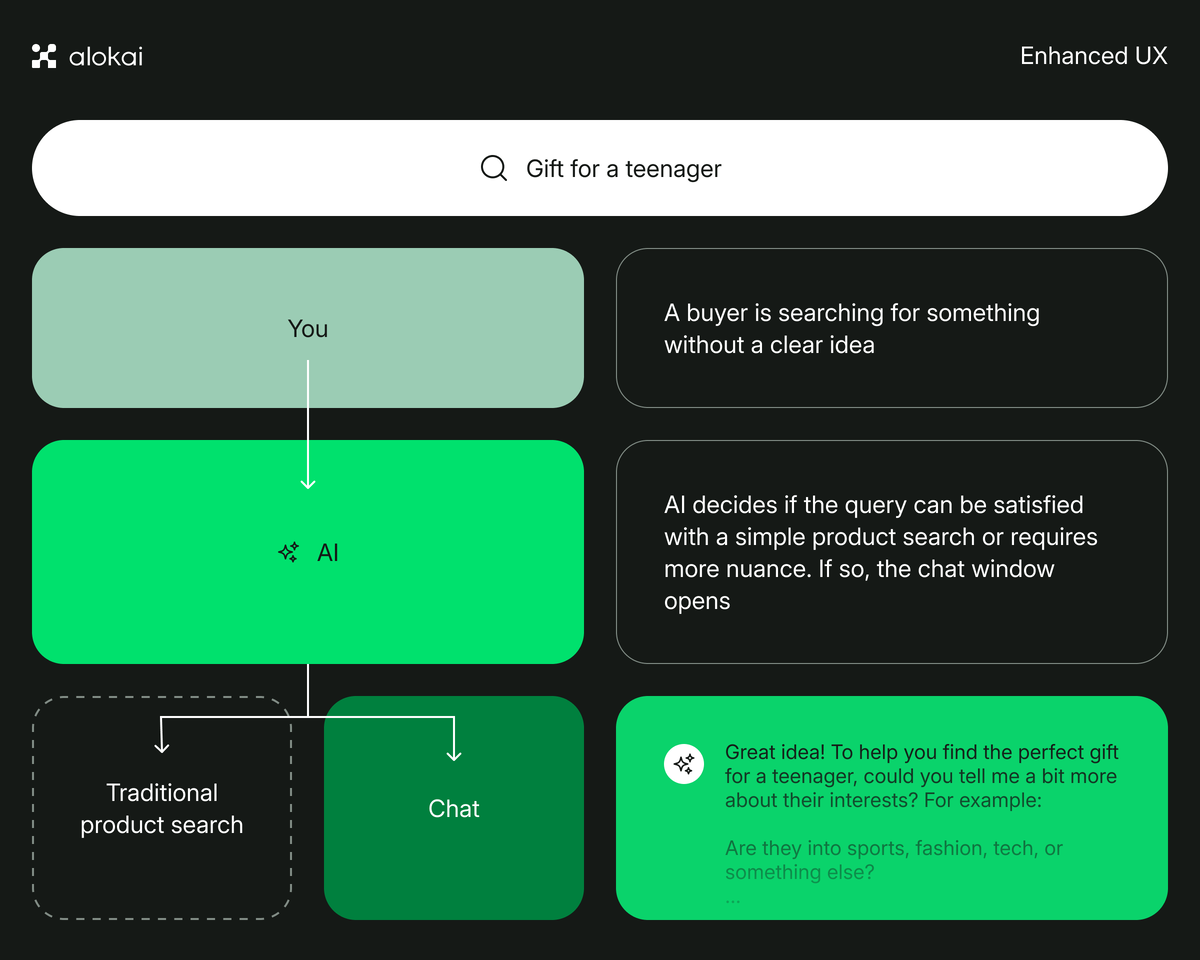The future of conversational commerce: will your brand stay relevant?
Sponsored by AlokaiAs conversational commerce expands, brands risk invisibility, making the brand identity and customer retention more important than ever.

We may be entering a bold new era of commerce: thanks to generative AI, consumers could soon shop directly through chat interfaces, skipping traditional websites entirely. Does this mean that this “conversational commerce” promise of convenience and personalization may be also silently killing brand commerce?
The promise and peril of native checkouts
Native chat checkouts allow you to browse, choose, and order products directly from your favourite genAI solution.
So what’s the catch?
Brand dilution
The expectations behind the technology are clear: every product should be able to be located via the native genAI interface, with no click-through to your e-commerce or infinite browsing, just pure intent-driven shopping. That’s the future of conversational commerce, after all!
Yet this model also threatens to blur or even erase distinct brand identities. If consumers no longer navigate to brand-owned sites or see dedicated product pages, how long before brand names fade from the decision process?
Given the effort, time, and budget spent building brand recognition, loyalty, and awareness, that shift could be existential for retailers.
Almost 58% of buyers prefer brand sites to any other alternatives for online shopping, so it’s definitely too early to give up on brand commerce.
Limitations
Many brands’ unique value is the shopping experience they provide to their customers.
They choose certain brands over others, because of special shop mechanics, configurators or just an intuitive interface that helps them to find the products they want. In a generic marketplace-like chat interface, these values can no longer be offered, which results in a less accurate and less intuitive shopping experience.
Does it mean that conversational commerce is just not a good fit for brands?
Absolutely not!
Chat is just another sales channel
A good way to think about conversational commerce is just as another sales channel.
It’s definitely a new and revolutionary one, but it’s important to see the reality beyond the hype. I still remember when people were saying that e-commerce stores would disappear when the first large global marketplaces started to gain popularity. They didn’t. In fact, the brand-owned e-commerce stores became a must-have for most companies.
When we think about buying through generic chat platforms, we think of a more convenient and personalised version of a conversational marketplace. As such, this sales channel tends to be most appealing to brands that already operate on marketplaces—those that don’t need full control over the buying journey and instead benefit from the added discoverability these channels provide.
And most people will shop on a marketplace when given the opportunity:

Larger brands, however, often prefer to stay in control of the entire customer experience. Relying on third-party channels means surrendering that control to external platforms that will inevitably prioritise the highest bidders and charge additional fees. For many big companies, that’s a dealbreaker—while for smaller sellers, it may just be a minor trade-off.
Ultimately, it all comes down to priorities.
Existing channels need to adjust
The impact of AI on conversation commerce goes far beyond creating new, more convenient sales channels. People are already getting used to new ways of interacting with web and traditional, brand-owned storefronts will need to adjust to this new behaviour sooner than later if they want to stay competitive.
People want instant answers and will be much less forgiving of the traditional web interfaces’ limitations. These will need to offer the same level of convenience while remaining unique and true to the brand.
What makes a successful AI storefront
A simple chatbot on the bottom right corner will not transform the experience. You need to turn the whole storefront into an adaptive, AI-driven experience.
Enhanced user experience
AI needs to work as an invisible layer on top of the traditional interface, filling the gap in the flawed static interface. For example, if a user fails to get a result they were searching for, a chat window can pop up and ask some follow-up questions to locate the item or suggest alternatives.

Your AI agents will need to be as capable, if not more capable, than traditional interface. Which means they would need to be able to communicate with all API’s and cover the same functionalities (and more) as a regular interface.

Adaptable interfaces
What used to be static has to become adaptive. Forget about traditional filtering and attributes - users will create their own and categorise search results based on the qualities that matter to them (e.g., battery life or portability for laptops). Interfaces of the future will need to be adjustable on the fly by the end-users.

Form factor matters here. A simple text chat won’t fulfil every use case. The chat experience needs to display components identical to the ones in your static interface. In some cases, it should also be able to adjust the interface outside of it, e.g. by filtering a product listing or highlighting the most relevant elements.
All that means that the era of static storefronts is coming to an end.
Adaptive experience for guided commerce
Behaviours are already changing, and retailers who fail to adjust their stores to user expectations will see the biggest decline in online sales. In the end, people prioritise convenience over everything else.
AI is expected to assist with the shopping experience, facilitating processes like order tracking or price comparisons, not necessarily a completely different online shopping experience whatsoever.
We know that meeting this challenge is not an easy task. That’s why we launched Alokai Compass - a framework and toolkit that allows you to turn any static storefront into an adaptive e-commerce experience, using the best of AI capabilities without sacrificing familiarity.
E-commerce won’t be transformed in a day, but we can already see how the market is shifting. Shoppers are no longer satisfied with mediocre experiences and it’s up to retailers to ensure their storefronts are keeping up with the trends.
The future of conversational commerce (and beyond) is already here, the question is who’s defining that future.
Curious to learn more about what drives the buyers’ journeys of the future? Download Alokai’s E-Commerce Statistics Report 2026

Business Reporter Team
Most Viewed
Winston House, 3rd Floor, Units 306-309, 2-4 Dollis Park, London, N3 1HF
23-29 Hendon Lane, London, N3 1RT
020 8349 4363
© 2025, Lyonsdown Limited. Business Reporter® is a registered trademark of Lyonsdown Ltd. VAT registration number: 830519543





